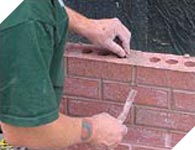
Aesthetically speaking, mortar joint tooling produces the joint profile in brick walls. When the “jointer” tool is struck against the mortar before the joint has set, a joint profile is made. Usually, this profile is concave but it can also have other configurations such as a grapevine or “v-shape.”
Not only does mortar joint tooling please aesthetically, there are also functional benefits. Proper tooling increases resistance to water penetration along the wall. The “jointer” tool compresses the mortar against the unit, helping seal any separation cracks that might form at the interface. The action of the jointer on the unset mortar brings the concrete fines in the mortar to the surface. This creates an exterior skin on the joint that is more resistant to water infiltration.
Timing is everything! It is crucial that tooling be done at the correct time. Too early and the joint will not seal, too late and it tends to pull the mortar away from the unit, rather than compress it. Tooling should be done when the joint is “thumbprint” hard, or when some of the moisture has been absorbed into the unit but there is still enough moisture to keep the joint flexible so that the fines can be brought to the surface. For color consistency, tool all of the joints at approximately the same moisture level throughout the job.
Another tip: the sequence of striking must be consistent — head, then bed joints, or vice versa. A good masonry craftsman should be well trained in proper tooling techniques.
For more information about masonry restoration in Massachusetts, contact Abbot Building Restoration at (617) 445-0274.


